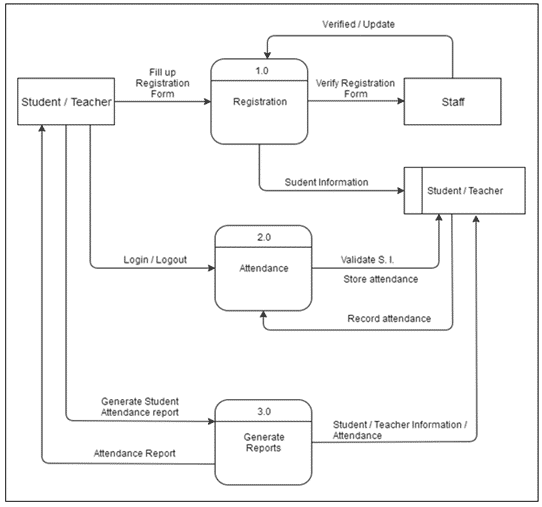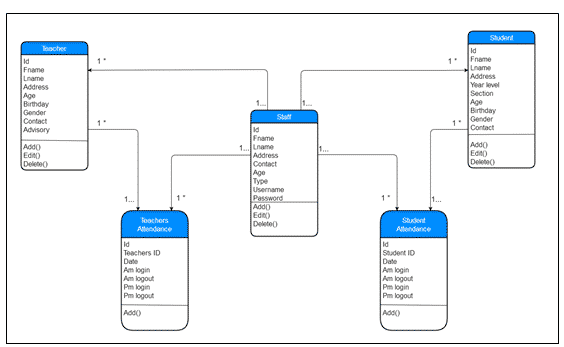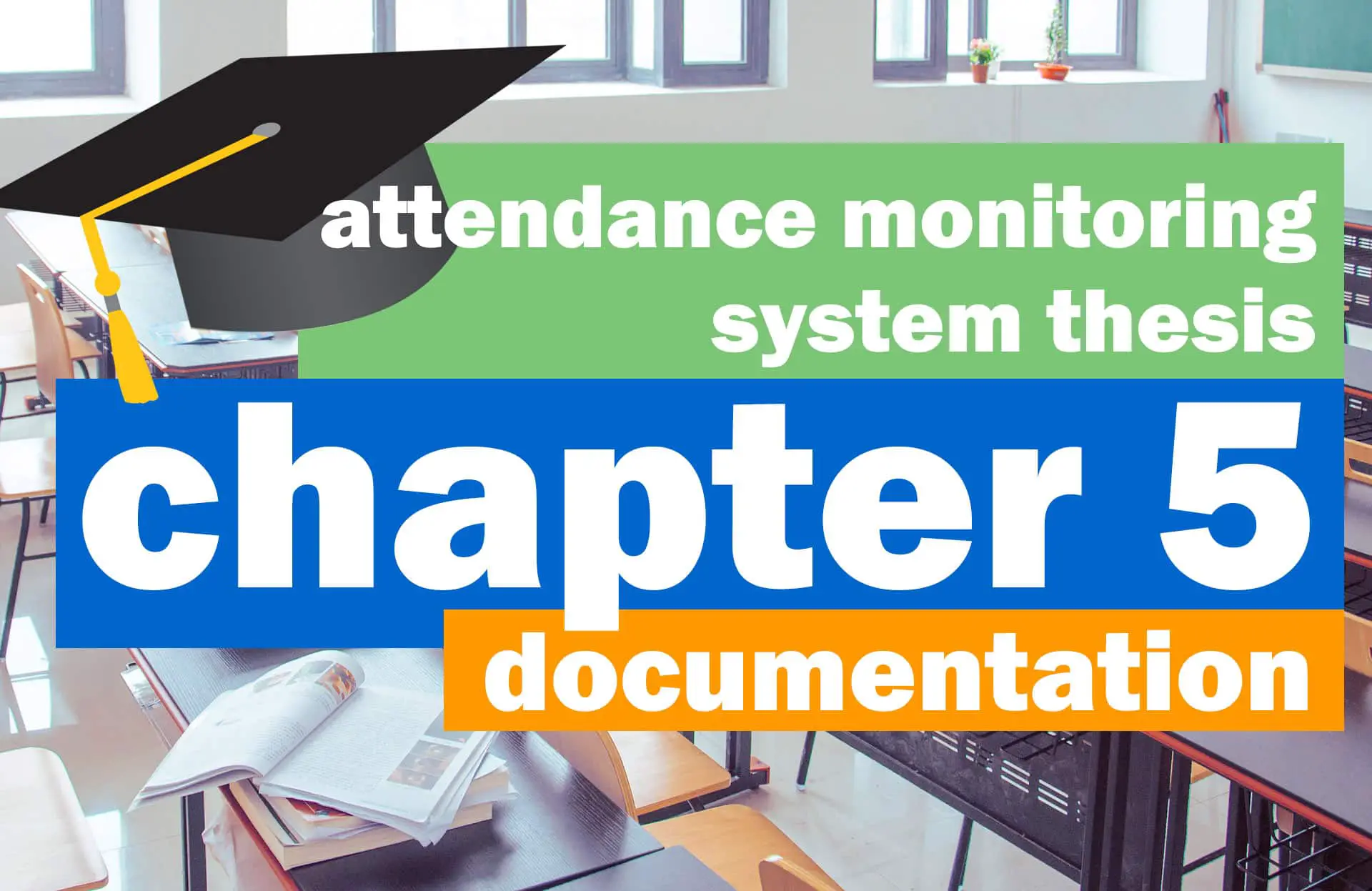Attendance Monitoring System Thesis Documentation | Chapter 5
This last chapter of the Attendance Monitoring System thesis is about your proposed system for your study. Mainly, you will discuss the proposed system you created to solve the problem.
Just like previous chapters, this article will guide you in completing your Attendance Monitoring System documentation with examples.
Before going to the example, let’s discuss the parts of chapter 5.
How to write Attendance Monitoring System Thesis Chapter 5
How to write Attendance Monitoring System Thesis Chapter 5
- Introduction
Write a short paragraph explaining the proposed solution and its benefits.
- Title and Brief Description of the Proposed Solution
Write your proposed solution’s title and description
- Scope of the Solution
In this section, write the coverage of your proposed solution in terms of features.
- Concept of Operation
The concept of operation will discuss the overall idea of the proposed solution’s operation.
- Use Case Diagram of the Proposed System
The use case diagram will illustrate the interaction of users with the proposed system. This will clearly show how the users interact with each module of the proposed system. It also has a use case description for each action of the user.
- Data Flow Diagram
The data flow diagram will represent the flow of your data from the user to your proposed system. The diagram also shows the inputs and outputs to each part of your proposed system.
- Data Dictionary
Your data dictionary lists your database tables and fields for a better understanding of the data captured by your system.
- Class Diagram
The class diagram shows the different classes, attributes, methods, and functions of your system and its relation to each other. This will show the structure of your system.
- Entity Relationship Diagram
The Entity-Relationship diagram shows the relationship of your tables in your database.
- Advantages and Disadvantages
In this section, you will state the advantages and disadvantages of implementing your proposed system and stick to the functionality of your proposed system as a basis for this.
- Technical Feasibility
Assess your proposed system if it is feasible based on your testing and availability of resources.
- Social and Operational Feasibility
Assess your proposed system if it is feasible in terms of the reactions of the users to your proposed system. You can state if the proposed system is user-friendly and has a significant impact on their operations.
- Economic Feasibility
Lastly, asses your proposed system if it is economically feasible. If your proposed system can minimize expenses in the overall operation, then it is economically feasible.
Now that we have discussed the steps in creating your last chapter, here is the sample document of Attendance Monitoring System Chapter 5.
Sample Attendance Monitoring System Documentation Chapter V
The Proposed Solution
Title and brief description of the proposed solution
The AMS for RTTNHS Su-ay Ext. is developed for the attendance monitoring of Raymundo T. Tongson NHS Su-ay Ext. The system is a window – based system that has the function to record the attendance of the students and teachers.
The proposed system covers the problem of using the manual system such as an unsecured record of attendance, lots of paper works, and inaccuracy of the data inputs.
This proposed system will benefit the school for its development and improvement by using a new technology and improved system for the day-to-day process of attendance.
The proposed system is entitled Attendance Monitoring System for Raymundo T. Tongson NHS Su-ay Ext. The system is developed to provide automation for the daily attendance of the students and teachers. The purpose of this system is to help the RTTNHS Su-ay Ext. to improve the attendance monitoring system for students and teachers.
With the system created with a user-friendly environment, the school staff would find their work easy and efficient. The system will help the school administrators to make the process of providing daily, weekly and monthly attendance reports easy to generate.
The system will also help the school administrators to evaluate the attendance performance of the students and teachers with ease. This will help the school a lot for its development and performance in terms of attendance monitoring.
Scope of the Proposed Solution
The proposed system was generally focused on the monitoring of the login and logout of the students and teachers. Students and teachers will only provide their identification code for their attendance after registering their information. The system will automatically determine and reflected if a student did not attend his classes.
Concept of Operation
The implementation plan will be enhanced and updated as new actions are introduced and implemented to the system. The system tracks the performance of students regarding their attendance on a regular basis.
The System Overview Attendance Monitoring System provides a foolproof solution for the existing problems of the business.
Attendance Monitoring System for RTTNHS Su-ay Ext.

Figure 5 shows how the proposed system works and interacts with the actors. First, the staff will register the students and teachers after registration, the staff will record the attendance of the students and teachers using the provided identification number and save to the database.
The staff can view attendance and create a report for the teachers and students. Students and teachers must request the staff to view their attendance records.
Use Case Description
The tables below describe all the functions, conditions and alternative flow to be met of all the entities used in the use case diagram of the proposed solution.
Table 1: Register
| Use Case Name | Register |
| Primary Actors | Staff, Student, Teachers |
| Description | The staff will register the student’s and teacher’s information. |
Stakeholder and Interests | Students and teachers – registering the basic information. Staff – Responsible for the inputting of the student and teacher’s information. |
| Pre-condition | The student must be officially enrolled in the school. Teachers must be employed in the school. |
| Post-condition | Student and teachers added as a new member |
| Main Success Scenario | Students and teachers will receive their ID Numbers. |
Table 2: Record
| Use Case Name | Record Attendance |
| Primary Actors | Staff, Student, Teachers |
| Description | The staff will record the registered students and teachers. |
| Stakeholder and Interests | Student and teachers – present ID number and have a daily attendance Staff – Record attendance using ID number |
| Pre-condition | The students and teachers should have the identification card provided after registration. |
| Post-condition | If preconditions met, then the staff will enter the id number and record attendance. |
| Main Success Scenario | Students and teachers have their daily attendance. |
Table 3: View Record
| Use Case Name | View Record |
| Primary Actors | Staff, Student, Teachers |
| Description | The students and teachers can view their attendance detail. |
| Stakeholder and Interests | Students and teachers – want to view their attendance records. Staff – search for the attendance details of students or teachers. |
| Pre-condition | In order to view attendance records, they must present their identification cards to the staff will search for their attendance details. |
| Post-condition | If the precondition is met, then the staff will search for the attendance detail |
| Main Success Scenario | Students and teachers view their attendance detail. |
Table 4: Generate Report
| Use Case Name | Generate Report |
| Primary Actors | Staff |
| Description | The staff will create the daily and monthly reports of attendance. |
Stakeholder and Interests | Staff – must generate daily and monthly report |
Pre-condition | The staff must log in as an administrator and access the report form. |
Post-condition | If the precondition is met, then the staff create the report specific for students and teachers. |
Main Success Scenario | The report will be provided to the school administrator for the evaluation of the student and teachers. |
Attendance Monitoring System for RTTNHS Su-ay Ext.
Data Flow Diagram

Figure 6 shows that in the proposed system, the staff will register the student or teacher and to be verified by the staff. The registration is only a one-time process for each student and teacher.
After the registration, it will continue to log in and record for daily attendance. The proposed system can generate records daily or monthly according to the students’ or teachers’ requests.
Proposed System Data Dictionary
The tables below show the list of conceptual database of the proposed solution. It shows the attributes, data types, and descriptions to be included in the database.
This ensures that the information needed was captured by different databases.
Table 5: tblstudent
FieldName | Description | Type | Length |
| STD_ID (pk) | Student ID number | int | 11 |
| STD_FNAME | First name | varchar | 30 |
| STD_LNAME | Last name | varchar | 30 |
| STD_ADDRESS | Address | varchar | 50 |
| STD_YEAR | Year Level | varchar | 10 |
| STD_SECTION | Section | varchar | 10 |
| STD_BIRTHDAY | Date of Birth | varchar | 30 |
| STD_AGE | Age | int | 3 |
| STD_GENDER | Gender | varchar | 10 |
| STD_CONTACT | Student Contact Number | varchar | 30 |
Table 6: tblstaff
FieldName | Description | Type | Length |
| STF_ID (pk) | Staff ID number | Int | 11 |
| STF_FNAME | First Name | varchar | 30 |
| STF_LNAME | Last Name | Varchar | 30 |
| STD_ADDRESS | Address | Varchar | 50 |
| STF_CONTACT | Contact Number | varchar | 20 |
| STF_TYPE | User Type | varchar | 30 |
| STF_USERNAME | User Username | varchar | 30 |
| STF_PASSWORD | User password | varchar | 30 |
Table 7: tblteacher
FieldName | Description | Type | Length |
| TEA_ID (pk) | Teacher ID Number | varchar | 15 |
| TEA_FNAME | First Name | varchar | 30 |
| TEA_LNAME | Last name | varchar | 30 |
| TEA_ADDRESS | Address | varchar | 50 |
| TEA_AGE | Age | int | 3 |
| TEA_BDAY | Date of Birth | varchar | 30 |
| TEA_GENDER | Gender | varchar | 10 |
| TEA_CONTACT | Contact Number | varchar | 20 |
| TEA_ADVISORY | Advisory | varchar | 20 |
Table 8: std_attendance
FieldName | Description | Type | Length |
| SATT_ID (pk) | Student Attendance ID | int | 11 |
| STD_ID (fk) | Student ID number | int | 11 |
| SATT_DATE | Attendance date | varchar | 30 |
| SATT_AM_IN | Am Login | varchar | 10 |
| SATT_AM_OUT | Am Logout | varchar | 10 |
| SATT_PM_IN | Pm Login | varchar | 10 |
| SATT_PM_OUT | Pm Logout | varchar | 10 |
Table 9: tea_attendance
FieldName | Description | Type | Length |
| TATT_ID (pk) | Teacher Attendance ID | int | 11 |
| TEA_ID (fk) | Teacher ID number | varchar | 15 |
| TATT_DATE | Attendance date | varchar | 30 |
| TATT _AM_IN | Am Login | varchar | 10 |
| TATT_AM_OUT | Am Logout | varchar | 10 |
| TATT _PM_IN | Pm Login | varchar | 10 |
| TATT _PM_OUT | Pm Logout | varchar | 10 |
Proposed System Class Diagram
Attendance Monitoring System for RTTNHS

Figure 7 shows the database tables used for RTTNHS Su-ay ext. attendance monitoring system. It indicates the functions and relation to each table. The student, teachers, and staff table show that data can be added, updated and can be deleted while attendance table for students and teachers can only be added
Proposed System Entity Relationship Diagram
Attendance Monitoring System for RTTNHS

Figure 8 shows the relationship of tables of the proposed system in the database, an ERD is shown to trace the connection of each table. The models of the data were used independently of all physical consideration is constructed. The model is based on the requirements specification of the proposed system.
The design also considers the logical and physical database design phase meaning the design is based on the target data and base relations, indexes, integrity constraint, security are defined using SQL Language.
The database management system (DBMS) used was MySQL and the design user interface and the application program that use and process the database are defined and designed.
Advantages
- Reduce paperwork and save time
and money with mobile and cloud-based attendance management system - Eliminate duplicate data entry
and errors in time and attendance entries - Improve visibility to track and
manage student’s attendance & absenteeism across multiple campuses - Track the attendance of
teachers and students. - Keep the parents informed about
the student’s performance - Auto-generate various types of
reports of student attendance - Increased security and confidentiality with
role-based permissions to users
Disadvantages
- Automatic calculation of leave
and reward points accrued - Automatic teachers and student
evaluation about the attendance performance. - Scheduling of events in the school.
Technical Feasibility
During the research development of AMS RTTNHS Su-ay ext., we conclude that the system is technically feasible because all the technical aspects of the system are already available presented to the organization throughout the research.
Social and Operational Feasibility
The AMS RTTNHS Su-ay ext. is social and operational feasible because the system is designed as a user-friendly system and accordance to the client’s needs for the effectiveness of the operation and process of delivering the desired output needed by the client.
Economic Feasibility
The proposed system being developed is economic with respect to the school’s point of view. It costs effective in the sense that it has eliminated the paperwork completely.
The system is also time effective because the calculations are automated which are made at the end of the month or as per the user requirement. The result obtained contains minimum errors and is highly accurate as the data is required.
Conclusion
Congratulations! You have completed the last chapter of Attendance Monitoring System Thesis!
Now that you have read through the sample proposed solution of the attendance monitoring system, you are now ready to finish your Attendance Monitoring System Thesis.
This attendance monitoring system documentation chapter 5 is free to modify. Surely, this guide will help you finish your own attendance monitoring system documentation.
Here is the complete outline of the Attendance Monitoring System Thesis Documentation guide:
- Chapter 1 – Introduction
- Chapter 2 – Review of Related Literature
- Chapter 3 – Methodology
- Chapter 4 – Existing System
- Chapter 5 – Proposed Solution

